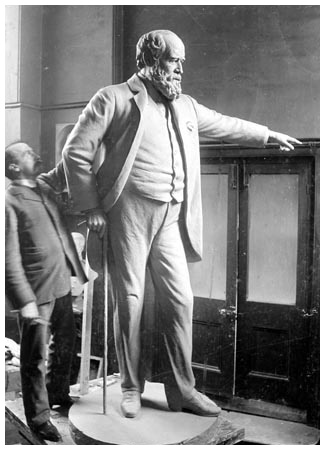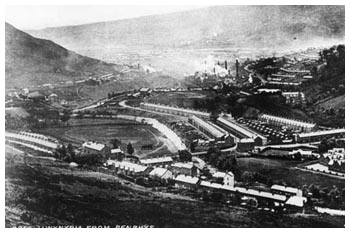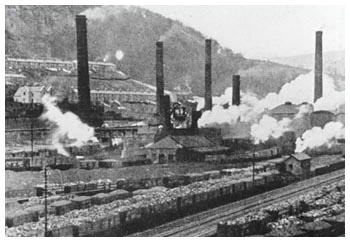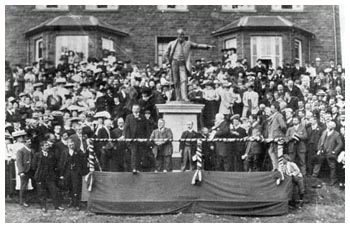
Llwynypia |
|
The name Llwynypia translates as, ‘The grove of the bush of the magpie', and in common with many villages in the Rhondda Llwynypia derives its name from a farm that stood on the land pre-industrialisation. The noted nineteenth century traveller and author Benjamin Heath Malkin described the area as, ‘a region of beautiful fields with a magnificent grove at the upper end under the shadow of a towering rock'. |
|
The area changed little until, in 1859, Isaac Smith managing director of Church Colliery, Pentre opened a small level seeking coal measures beneath Llwynypia farm. The venture encountered numerous problems and soon was abandoned. It was later, in 1862 that a man that was to shape the landscape and history of Llwynypia first came to the area, that being Archibald Hood. Hood was a successful and ambitious Scottish mining engineer and first came to the Rhondda in 1860. As part of the Ely Valley Coal Company, Hood had negotiated the lease of the upper coal seams at Llwynypia and sunk Llwynypia No.1 pit to the Rhondda No2 and No.3 seams in 1863. Numerous problems were encountered in Hood's first enterprise in the Rhondda, mainly due to water and sand in the workings
|
General view of Llwynypia from Penrhys |
| Later, under the new name of The Glamorgan Coal Company, Hood extended the lease on the lands at Llwynypia and sank new pits to the more sought after steam coal measures. It was here that Hood met with remarkable success and in 1873 Llwynypia No.4 and No.5 pits were opened to the steam coal measures. By 1908 when the Company became part of the Cambrian Combine it was working five large pits at Llwynypia employing thousands of local men and boys. | |
Scotch Colliery Circa 1910 |
As well as the mining of the coal Llwynypia became synonymous with good quality coking coal, highly prized at that time by the Admiralty and foreign markets. By 1914 Llwynypia had one hundred and forty coke ovens, as well as its own substantial brickworks. When the Collieries became part of The Cambrian Combine in 1908 the waste gases from the coking process were used to provide electricity not only for the colliery itself but also for street lighting for the surrounding areas. |
He was a popular figure with his workforce and upon his death in 1902 tributes flowed in praising his treatment of his workers. In 1906 outside Llwynypia Miners' Institute the local MP, William Abraham, unveiled a statue of Archibald Hood much of the cost of which was met through donations from his workers. |
Unveiling the statue of Archibald Hood 1906 |
 |
Prior to the coming of the coal industry Glyncornel was a simple hillside farm, owned by the DeWinton family and farmed by Thomas Bevan in the 1840's. However Hood constructed a substantial home on the site, Hen Glyncornel, for his son William Walker Hood. Then in the early 1900's on the mountainside above Hen Glyncornel, The Cambrian Coal Combine built Glyncornel House to house its senior managers, one notable resident being Leonard Llewellyn. Rhondda Borough Council eventually took over the house in 1939, using it as a maternity hospital until 1959 when it became a geriatric hospital, then after 1979 it was used as the Rhondda Museum as well as having been a youth hostel and Environmental Centre. During the Second World War Glyncornel was used as an auxiliary hospital, as well as housing ‘unmanageable' evacuee children. Llwynypia is also the name of The Rhondda's main hospital. Built in the first years of the twentieth century as a workhouse to cater for the overflow from the current building in Pontypridd, and subsequently expanded and converted to become the first general hospital in the Valley. Left: Sculptor Walter Merritt working on his statue of Archibald Hood, circa 1905. Bronze statue erected in front of the Llwynypia Miner's Library and Institute in 1906, Workmen of Hood's collieries contributed £600 towards its erection. |


